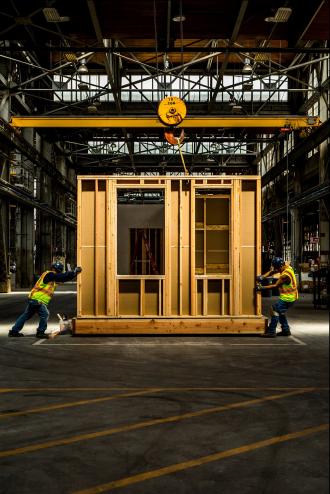California is in the middle of an affordable-housing crisis that cities across the state are struggling to solve. College of Environmental Design alumnus Rick Holliday (M.C.P. ‘77), a longtime Bay Area real estate developer, thinks one answer lies in an old shipyard in Vallejo, about 40 minutes northeast of San Francisco.
Here, in a football-field-sized warehouse where workers used to make submarines, Holliday recently opened Factory OS, a factory that manufactures homes. In one end go wood, pipes, tile, sinks and toilets; out another come individual apartments that can be trucked to a construction site and bolted together in months.
“If we don’t build housing differently, then no one can have any housing,” Holliday said during a recent tour, as he passed assembly-line workstations and stacks of raw materials like windows, pipes and rolls of pink insulation.
Almost a decade after the recession flattened the housing industry, causing waves of contractors to go bankrupt and laid-off construction workers to leave the business for other jobs, builders have yet to regain their previous form. Today the pace of new apartment and housing construction sits at a little over half the 2006 peak.
The United States needs new housing, but its building industry isn’t big enough to provide it. The number of residential construction workers is 23 percent lower than in 2006, while higher-skill trades like plumbers, carpenters and electricians are down close to 17 percent. With demand for housing high and the supply of workers short, builders are bidding up prices for the limited number of contractors.
Construction prices nationwide have risen about 5 percent a year for the past three years, according to the Turner Building Cost Index. Costs have gone up even faster in big cities and across California, according to RSMeans, a unit of Gordian, which compiles construction data. In the Bay Area, builders say construction prices are up 30 percent over the past three years — so much that even luxury projects are being stalled by rising costs.
The surge in construction prices is coming at the worst possible time for booming cities like New York, Seattle and San Francisco, already dealing with an affordable-housing crunch that has increased the homeless populations and stoked acrimonious debates about growth and gentrification. City and state legislators have tried to tackle their housing problems with proposals to increase subsidized affordable housing, reduce building regulations and make it legal to build taller.
But even if every overpriced city suddenly overcame the thicket of zoning rules and neighborhood opposition that make it difficult to build new housing in the first place — which seems doubtful — today’s diminished building industry would lack the capacity to build at the needed pace. This affects the rich as well as the poor, because it raises the cost of high-end condos and affordable housing alike.
All this has prompted developers like Holliday to go scrambling for cheaper and less labor-intensive construction methods. The technologies vary but generally involve simplifying construction through prefabricated panels that can be assembled like Ikea furniture and modular apartments that can be stacked together like Lego bricks. Instead of single-family homes, companies doing prefab building are focusing on higher-density condominiums and apartments. That’s because, while single-family home construction remains well below its level before the recession, multifamily condominium and apartment buildings have rebounded strongly.
Holliday started thinking about modular housing about four years ago, when he was struggling to build a project in Truckee, Calif., a mountain town of about 15,000 people near Lake Tahoe. The idea was to build a cluster of 800 to 1,000 high-density apartments and condominiums, but “the numbers wouldn’t work,” he said. “You couldn’t get the construction costs down enough.”
Holliday floated the idea of modular building to his longtime contractor, Larry Pace, from Cannon Constructors, who over the past four decades has built various projects from one-off homes to high-rise condo and office towers. “I said ‘modular jobs have been a fiasco — we don’t need that in our lives,’” Pace recalled.
But Holliday persisted, and he and Pace used modular technology from two manufacturers to build four projects in the Bay Area. They are planning to do the same with the original Truckee development. Pace became so comfortable with modular that he suggested that they find some investors and build a factory of their own.
On a recent afternoon, Pace laid out the factory’s process. At the first station, just past the door, four workers toiled above and below a raised platform to build what would eventually become the floor. The two men up top laid down flooring while a man and woman stood below simultaneously installing pipes.
From there the unit would move steadily down the line, and, over 21 additional stations, would acquire toilets, indoor walls, outdoor walls, a roof, electric outlets, windows, sinks, countertops and tiling. It takes about a week to finish a unit, Pace said. The goal is to churn out about 2,000 apartments a year, which would be turned into four- and five-story buildings with 80 to 150 units each.
